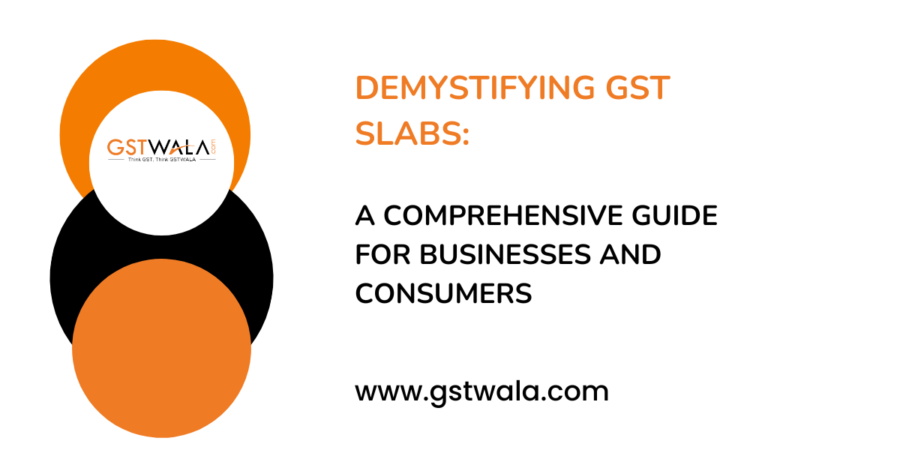
Demystifying GST Slabs: A Comprehensive Guide for Businesses and Consumers
The Goods and Services Tax (GST) system in India represents a significant departure from the erstwhile tax structure, aiming to streamline tax classifications and enhance transparency in the taxation regime. As businesses and consumers navigate through this reformed tax landscape, it becomes imperative to gain a comprehensive understanding of GST slab rates. In this comprehensive guide, we embark on an exploration of the intricate facets of GST slabs, delineating the items categorized within each slab, elucidating the corresponding GST percentage rates, delineating the types of GST, and providing insights into the methodology for calculating GST. By delving into these intricacies, businesses and consumers alike can equip themselves with the requisite knowledge to navigate the GST regime effectively and ensure compliance with the prevailing tax regulations.
Top of Form
What Are the Slabs of GST in India? GST in India is categorized into four main slabs:
- 5% GST Slab: Includes essential goods like basic food items, common-use items, and transportation services.
- 12% GST Slab: Encompasses mid-range goods and services such as processed food, healthcare, and financial services.
- 18% GST Slab: Applies to non-essential goods like certain consumer durables, IT services, and upscale restaurants.
- 28% GST Slab: Reserved for luxury goods, sin goods, and demerit goods like automobiles, tobacco products, and high-end consumer durables.
Which Items Are in the 28% GST Slab? Luxury goods, sin goods, and demerit goods fall under the 28% GST slab, including luxury cars, aerated drinks, and high-end consumer durables.
Which Items Are in the 18% GST Slab? The 18% GST slab covers items such as air conditioners, refrigerators, IT services, and certain hotel and restaurant services.
What Is the GST Percentage Rate? GST rates vary from 5% to 28%, depending on the category of goods or services purchased or rendered.
What Are the 4 Types of GST? The four types of GST in India are:
- Central Goods and Services Tax (CGST)
- State Goods and Services Tax (SGST)
- Integrated Goods and Services Tax (IGST)
- Union Territory Goods and Services Tax (UTGST)
Which Items Are in the 12% GST Slab? The 12% GST slab includes processed food items, textiles, medicines, certain healthcare services, and financial services.
On Which Items Is the GST Rate 5%? Essential goods and services such as basic food items, healthcare services, and transportation services fall under the 5% GST rate.
How Is GST Calculated? GST is calculated by multiplying the value of goods or services by the applicable GST rate using the formula: GST Amount = (Value of Goods or Services) × (GST Rate/100).
What Is Normal GST? Normal GST refers to the standard GST rates applicable to most goods and services, which range from 5% to 28%.
In conclusion, it is evident that a comprehensive understanding of GST slab rates, percentage rates, and classifications holds paramount importance for businesses and consumers operating within the Indian taxation framework. The implementation of the GST system marks a significant shift in tax structures, aiming to simplify and rationalize the tax regime, thereby fostering transparency and enhancing compliance.
By acquainting themselves with the applicable GST rates and the diverse slabs under which goods and services are categorized, businesses can navigate the regulatory landscape with precision. This understanding enables them to ensure compliance with tax obligations, conduct accurate tax calculations, and make well-informed pricing decisions, thereby bolstering their operational efficiency and competitiveness in the marketplace.
Similarly, for consumers, a comprehension of GST slab rates facilitates an understanding of the tax implications associated with their purchases. This fosters transparency and clarity in transactions, empowering consumers to make informed decisions regarding their expenditure.
In essence, by embracing the nuances of GST slab rates, percentage rates, and classifications, both businesses and consumers contribute to the overarching objective of the GST system—promoting transparency, fostering compliance, and facilitating seamless transactions in the Indian economy.
Stay ahead of the curve with gstwala.com; Together, let’s simplify GST for a smoother business journey.
We are just a click away info@gstwala.comTop of Form
